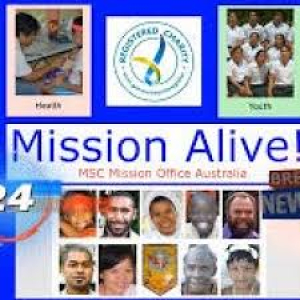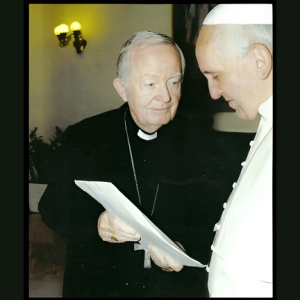Peter MALONE
Joker: Folie a Deux
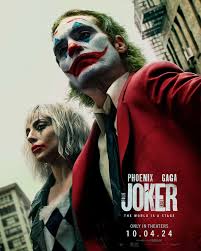
JOKER: FOLIE a DEUX
US, 2024, 138 minutes, Colour.
Joaquin Phoenix, Lady Gaga, Brendan Gleeson, Catherine Keener, Zazie Beetz, Steve Coogan, Harry Lawty, Leigh Gill, Ken Leung, Jacob Lofland, Bill Smitrovich.
Directed by Todd Phillips.
Unexpected – to say the least. Disconcerting… Intriguing…
In 2019, the reworking of the Joker story, many memories of Batman films, was hugely successful, a blend of action and psychological probing of the character of Arthur Fleck, Joker. And, Joaquin Phoenix one the Oscar for Best Actor.
Five years later. Great expectations. A sequel with the intriguing title, Folie a Deux, meaning a shared madness, a psychological description, raising the question of whether the madness of two is the shared madness of Joker and Arthur Fleck or, with the casting of Lady Gaga as Harleen Qninzel, the emerging Harley Quinn, the madness is of the relationship between Joker/Arthur and Harley Quinn.
But, the immediate response to the film on release was highly hostile. Words like “disappointing”, “disaster”, “boring…” resounded through social media, and critics not so enthusiastic either.
This review will be for the affirmative, for Joker Folie a Deux being an intriguing experience of unexpected filmmaking.
Its plot is the aftermath of the original film startlingly recaptured in an opening 3 minute Loony Tunes cartoon. The film is something of an epilogue in terms of the more modest scale of the action. We have seen Joker/Arthur Fleck killing people. Now he is in prison. In fact, quite an amount of the action takes place in the prison, unsympathetic and brutal guards (led by very Irish Brendan Gleeson), some of the inmates supportive, a young quizzical inmate watching Arthur intently and definitely making a final statement about his perspective on Arthur.
Otherwise, the action takes place in the courtroom, his lawyer, Catherine Keener, hoping that Arthur will prove to the court that he is mentally ill. By contrast, lawyer Harvey Dent (Harry Lawty from Industry) more than a touch of the smug, wants to convict Arthur and for Arthur to convicted himself. Fairly straightforward scenario.
But, the other star of the show is Lady Gaga, a presence who creates a limelight around her. And, of course, she sings.
Some promotion discussion has arisen about whether the film should be called a musical or not. From this reviewer’s point of view, it is a musical. There is a huge range of songs listed in the final credits, many of the hits of musical theatre that we are familiar with, think If My Friends could see Me Now, What the World Needs now…, And, finally, poignantly and to the point, Jacques Brell’s If I Go Away…
Already in prison, Arthur Fleck bursts into song, Joaquin Phoenix’s voice distinctive, and, throughout the film, dancing, with Lady Gaga, eventually even a tap dance. And, as in musical theatre, many of the dancers are dream sequences, songs and routines in the fantasies of both Arthur and Harley Quinn. The lyrics, many of which we know so well, are inserted to highlight the mentality of the characters, what they are experiencing.
Which raises the key question of this film: is Arthur Fleck mentally ill? Is he schizophrenic? Is Joker part of his personality or, as it is literally, a mask, a projection? This is discussed in the court case with a number of experts being cross-examined. And it emerges in the court case when Arthur decides to sack his lawyer and do his own defence. Does he defend himself? How does Arthur see the Joker? And who committed the crimes, the mad Joker or the Arthur who grew up in poverty, unloved, a vicious mother…?
It would seem that the very strong finale, the close-up of Arthur himself, of his eyes, does provide an answer.
This is the kind of film which we have seen in the past, reviled on release, reconsidered, eventually becoming something of a cult film as it is understood more and more. With its blend of realism, fantasy, song and dancing, it is something of an arthouse/ comic book creation.
- Sequel, expectations from the original?
- Audience response, low, MD rating, the bloggers, audiences wanting their money back…? Hostility?
- Reimagining of Arthur Fleck and Joker, the title, the folly and madness, of two, Arthur and Joker, in himself? The madness of Arthur/Joker and his relationship with Harley Quinn?
- The immediate tone, the animation, Loony Tunes in the tradition, the cartoon about Joker, recapping the issues of the original film, the murders, the confrontation on television?
- The film is a musical, Arthur and his ambitions, Joaquin Phoenix and his singing and dancing? The songs, in his head, Arthur singing? Dancing? His imagination, the lyrics and the relationship to the themes of the narrative? The popular songs on audience familiarity? Lady Gaga, reputation, singer, the songs in her imagination, with Arthur, song and pants?
- A prison film, the conventions, the harsh prison, the exteriors, interiors, the cells, the television room, the yard? Grim? A court film, the trial, the courtroom, those attending, the judge on the bench?
- The issue of Arthur as Joker, real, make up in mask, after identifying with Joker? His background as a child, abusive mother, orphanage, growing up alone, sensitive, reaction and the killings, ambition for television, the killing of the compere? Age, expectation, hopes? In prison, awaiting trial?
- The guards, conventional, the Irish atmosphere, the stories, wanting a joke from Joker, the brutality, yet happy to have the celebrity?
- Arthur’s lawyer, the discussions, her aims, to prove that Arthur was killed, her performance in court, being sacked?
- Harvey dent, smug, young, style, behaviour in court, the cross examinations, attacking Arthur?
- The judge, handling the situation, his decisions, Arthur imagining bashing the judge and Harvey dent?
- Harley Quinn, her story, her actual name, her version of her story, compared with the reality, her madness within herself, her parents, her actual name, the committee herself, seeing Arthur, the infatuation, wanting to be with him, relate to him, the discussions, the screening of The Bandwagon, That’s Entertainment? Setting the fire? The escape, together, back to jail? The bond, real and imaginary? Her presence in court, intense looking at Arthur? Outside the court?
- The fans, outside, in the court room, the make up, so many as Joker, the reactions, identifying with him? Support?
- The witnesses, serious, doctors, psychologists, the cross-examination, some of their interviews with Arthur, the credibility?
- Arthur, firing his lawyer, defending himself, his manner in the court, the stories, his challenge?
- The confrontation, who the Joker really is, the Joker in action? Or Arthur in action, accepting responsibility, the jury of their findings, the hostile reaction to the findings?
- The bomb, the damage, Arthur, the escape, the fans, in the street, those helping, supporting, the effect on Arthur and his being overwhelmed?
- In jail, the young prisoner and always supporting Arthur? The hostile prisoner, his expectations, the confrontation, killing Arthur? Carving the green on his face?
- Audience shock, the death of Arthur, the destruction of Joker? The brutal song, If you go away, Arthur dying, the close-up on his eye?
- The impact of the film and expectations from the audience? The possibility of audiences understanding this arthouse kind of film, the possibility of being a cult film?
MSC Mission Office, Roger Purcell MSC on the move
MSC Mission Office, Roger Purcell MSC on the move

This year has been a year of travel for the work of the Mission Office to meet with our overseas people, especially the National Directors. To visit projects and the recipients, and to see potential projects. In all places there are needs everywhere for water, assistance of students for school and training and for health. Fuller accounts in our Mission Outreach newsletter online.
Philippines (May 6-20. 2024)
I spent a couple of days in Manila to visit a Centre for the Poor helping school students and met with the Province. Then on to Butuan and El Monte on Mindanao to see, and stay in, more sites of the Centre for the Poor (CEPAGCO). This organization, CEntre for the Poor AGricultural Cooperative, is recognized by the Government and is an umbrella for a number of projects. it is Fr Richie Gomez msc initiative.
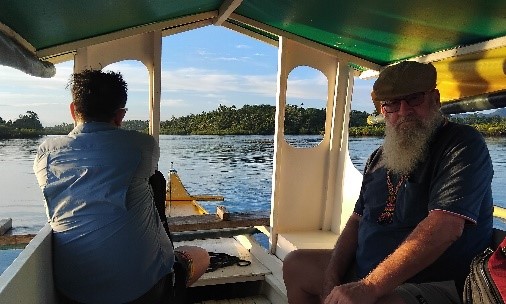
We visited St Luis parish with the school for the Indigenous Lumad people with over 100 students. Next was Surigao where the Dutch MSC began in 1908 and out to the Dinagat Islands. Here too we visited two Evacuation Centres housing people victims of a recent mining tailings dam collapse.
Vietnam: June 17th-25th
From Saigon (Ho Chi Minh City) we travelled to Hue in Central Vietnam. In the countryside we visited families of disadvantaged children needing assistance for school. A highlight was a visit to the shrine to the 117 Martyrs of the persecutions during the 19th-century. They were 96 Vietnamese, 11 Spaniards, and 10 French of whom half were clergy and half laypeople, including a 9-year-old child: 8 bishops, 50 priests, and 59 lay Catholics.

Indonesia: July 23-28
From Jakarta I went to Manado where our Seminary is with other MSC works, including a project to build a Centre for our Aged MSC. The highlight of the trip was Merauke in the Indonesian Province of Papua, which is now divided into 6 Provinces. Here I met with the Asmat people native to the area where we have funded two Formation Centres to give some education to children. A lot of their area is swampy and subject to flooding. The Dutch MSC worked there since 1905.
The Indonesian MSC Province is our largest working in many dioceses, from different regions and ethnic groups and are working throughout the nation from east to west over 3 times zones.

Democratic Republic of Congo; August 17-September 7.
This was the most difficult trip entering a country that is vast and remote, poor and oppressed by corruption so much so that people say “we have no government”. Kinshasha a city of 17 million people, is frankly, dirty, untidy and messy… a shock to the system.
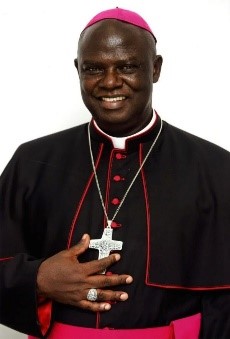
I visit Bishop Toussaint Iluku MSC in Bokungu-Ikela diocese, going by plane to Boende, then road to Wema and boat to Bokungu. This is a very remote part of our church and the welcome was very warm and genuine from the Bishop, priests, sisters and laity. Here and in Kinshasa the Sunday celebration was the Zairean rite which went for 2½ hours, which was considered short. It was lively, musical and energizing.
Memorials of two of our recent deceased confreres
Memorials of two of our recent deceased confreres
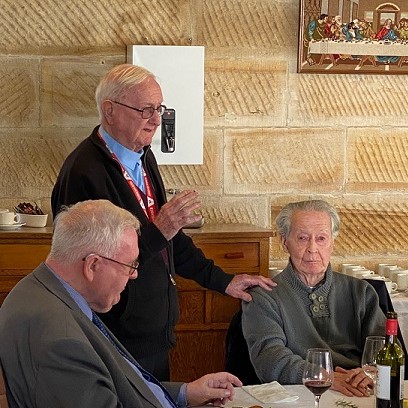
Arthur Stidwill MSC
Arthur supplied in Lismore Diocese, the parish of Casino,
A tribute to him by Fr Peter Slack,
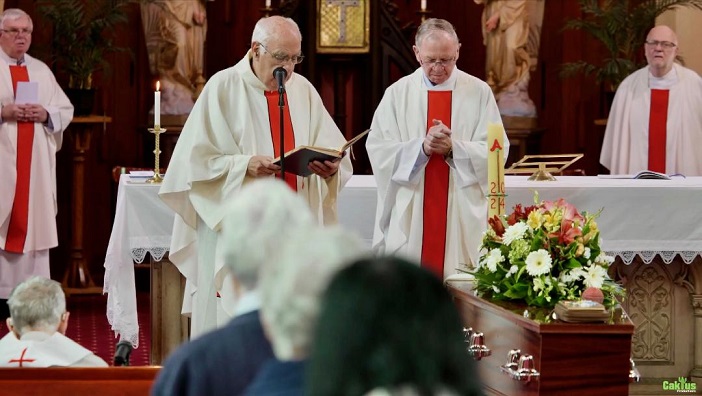
Naturally, I am sad but it is a strange sadness. Sad for myself that I will not see Arthur again, but not sad for him. After all he has reached journey’s end. I am reminded of Maurice West’s reflections in his memoir, “A View from the Ridge” he talks about death in these or similar words - Standing on a ridge overlooking a dark valley, I see the lights of the town, the aim of my journey. As I gaze at the lights I know that I must leave the comfort of the ridge and enter the dark valley in order to reach safely to the place that draws me, my home.
We first met in Ottawa in my salad days, he in late middle age. He had come from Alotau in his mid fifties to study Canon Law. He had a fine legal mind, sharp and precise. He loved the missions and his Bishop, Des Moore was a close friend and he served that diocese as Vicar General. He was an exemplary religious. Though he came to have a great affection for Casino, and they for him, he always said that he must return to religious home at Kensington. He lived the poverty. Any money he received always went to the MSC’s – he kept nothing. Mass offerings went to a poor school in Africa run by the Sisters of the Sacred Heart. Every day, twice a day, he would be found in Church saying his office.
Using Casino as a home, he helped out in South Grafton and Nambucca and Uralla. But he always returned home “to his religious confreres.”
Herein the parish he visited the elderly. Bishop Des Moore told him, “Arthur, the elderly need our ministry as much as the young. They need to experience the forgiving presence of Christ and tell their stories. They, like us, need healing.” As I grow into what was Arthurs’s age when he first came here to assist, I now appreciate the wisdom of those words.
He had one message – the love of Jesus. Every homily played upon the same theme. It is why the Missionaries of the Sacred Heart was founded, he would say.
When he was last here I invited him to give some talks to the parish. They were livestreamed and we have not only his voice but his face.
At his fiftieth the people the people put together a tribute to him. It now becomes his obituary.
Downlands
11/10/24
+
Very Rev Hugh Slattery MSC
Bishop of Tzaneen, SA. His life and times.
I would like to offer this personal tribute to Bishop Hugh.
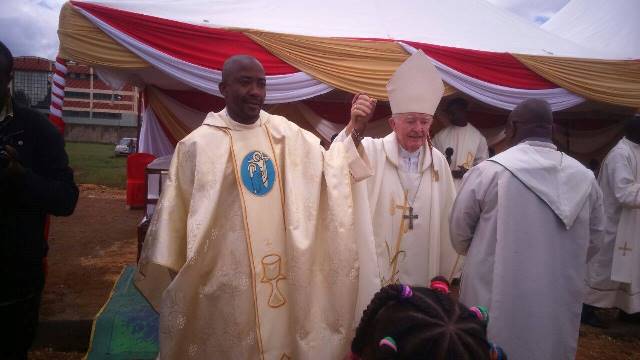
Bishop Hugh Slattery took me “under his wing” (as it were) when in late life (47) I first went to South Africa. He befriended me. He gave me a job, not just as Chaplain in St Brendan’s School but he also used my skills as a Geographer to produce a map of his diocese, especially the catholic installations. That took 6 months and a lot of driving and was a great introduction to the three language groups in the Diocese. At the end, it was the best map of that area I believe, and of those people who previously, under apartheid, had been considered “surplus to requirement!”. I could compare my map to others that had been produced post apartheid – such as Eskoms, done with GPS - and note their errors and mine. We located and named 800 villages – 200 Catholic facilities. + Hugh was grateful and urged me to continue studies to a PhD level. I didn’t.
Aids came in in the 1990s and the effect was devastating: deaths and funerals in all villages every weekend. The smoke arose from the cooking pots – set up to cater for the influx of mourners. Funeral societies grew rich. + Hugh took the lead combating it, establishing with the OLSH Sisters (Australian many) Kurisinani (“We care for each other”), and with his books and sermons counselled and encouraged his people through. Money and facilities began to arrive. I worked hard at being chaplain in the school, but also in holidays especially and with the aid of Kurisanani, worked on comprehensive programs to do with caring for the sick, Orphans, Youth and the redevelopment Married Life.
Severe floods in the year 2000 that destroyed 150 bridges in Limpopo Province was a “blip” along the way, but it demanded a lot of re-building of mud homes that had melted and collapsed in the downpour. The church was on the front foot in that reconstruction. 5 Million people live in Limpopo.
Bishop Hugh at that time was also completing the building of Ave Maria Pastoral Centre. That was a mighty effort – a fully functional Centre for over 120 people. I enjoyed there with adults and St Brendan’s students and the priests many a refreshing course. At an hour’s drive it became like a second home to me. + Hugh lived later there in retirement. + Hugh had also completed with the help of a Catholic Lay man architect and engineer, St Brendan’s College – which had 600 boarders when I started in 1997, and despite many turbulent times with deaths among staffs and students and difficulties with Governments, provided some of the best education in rural South Africa at that time. At one time we had to “sack” the principal for “grooming”. All the kids knew and approved the sacking! St Brendans was the first rural school in SA to have a set (20) of Computers – a second hand gift from the Anglo America Company in 1997. After his effort at completing the school, Bishop Hugh had to take extended leave.
We understood each other: I said one time “Bishop if you wont listen to me, I wont talk to you” – he did! But he also made it clear that he didn’t need my help in confirming as I had suggested. One day he confirmed 176 and it took several hours. Noone complained. They just enjoyed the singing and the dancing. Why stop when you are having fun!? I liked +Hugh’s straight talk.
Whenever he visited or I, we walked and talked and played Golf occasionally. I don’t think a lot of the new English Translation of the mass texts that we still suffer from – but + Hugh worked on that project with George Cardinal Pell, and had me convinced its was going to be the “ants pants”! More seriously, His first move with me was to get me to go to a three day seminar on Witchcraft at the University of the North. No joke! Witchcraft is a real thing in the Limpopo Province, the epicentre of it in Africa. They have a martyr in the form of Benedict Daswa to prove it. You are “the fool” if you discount it!
+ Hughs humour was of the dry type. He used to note that he set out from his home place to become an SMA (Society of Missionaries to Africa), and by mistake finished up at the MSC house on Cork. The SMA were founded in 1856 in France, so he wasn’t far out, and also had their novitiate in Cork! He also noted that he had more elephants (50,001 – in Kruger Park) in his Diocese than Catholics (50,000) – a mere 2% od the human population.
The elevation of Benedict Dazwa (Thsimagadzo - Wonder worker was his local name) was perhaps the crowning glory for Hugh. He asked me to take up the cause, and I replied “Ive got enough to do here (at school),” considering at a part time job. French Confrere Andre Boas MSC did it, went to Rome for 8 months, learnt Italian and three years later in 2016 the first South African lay man saint and martyr was proclaimed. This was a triumph for Bishop Hugh and a diamond in the MSC list of Martyrs.
In retirement Hugh and I remained friendly and would get together whenever I returned to SA, and when I was still there working in Holy Family Orphanage from 2015 onwards. Sr Sally Duigan was my boss. What a great work of mercy that is. It was established in the old MSC Novitiate/ seminary at Ofcolaco.
I have worked with/ for 11 Bishops and he was one of the best: friendly to me but not so well received by his Irish Confreres. His work in the Lumko Institutes with other Irish MSC – Paddy Whooley and Dick Broderick is well known, but that was before my time. Lumko is and was a great credit to our Irish Province with its grass roots theology, or is it “Cooking Pot Theology?” + Hugh could preach in the three local languages.
In retirement + Hugh was gracious and still interested in all things to do with church/ world. We corresponded occasionally. Im sorry to say I probably offended him in my last letter this year, having just re read Pakingham’s, The Scramble for Africa and Conrad’s Out of darkness. I asked simply: What really has the church done to improve the lot of Africans over 400 years? I’m sure +Hugh will forgive my bumptious questioning, and will add background to help me think with a better frame of mind.
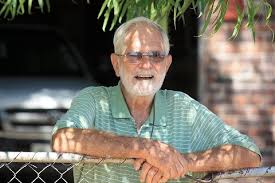
Vince Carroll MSC
Downlands College, MSC Education today
Downlands College, MSC Education today
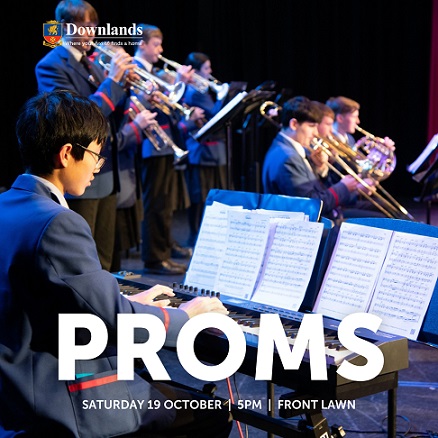
Downlands Performing Arts PROMS on Saturday 19 October, starting at 5pm on the Downlands Front Lawn. This free event is open to all Downlands families, friends, and the local community. Come and be dazzled by our talented performing arts students as they showcase their passion, from dance troupes and instrumental ensembles to various choir groups.

Did you know that each week, our Downlands students volunteer to make and serve breakfast for the students at a school in our neighbourhood? It’s a small act of kindness that goes a long way in building up community beyond the Downlands gates. We are proud of our students for their dedication and for being ‘good shepherds’ to the younger students in our community.
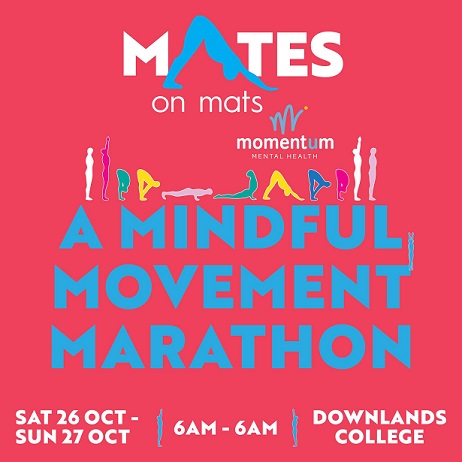
We're proud to be a sponsor and the host of Mates on Mats – A Mindful Movement Marathon for Mental Health. Join us from 26-27 October at our Jules Hall for 24 hours of mindful movement in the form of yoga.
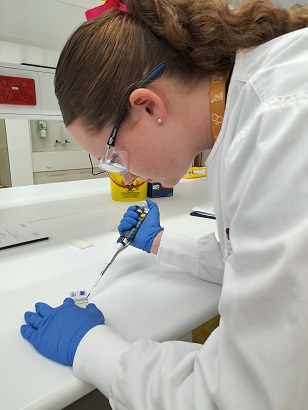
Our Year 11 student, Lori, recently explored the realm of science at the SPARQ-ed Immersion Program. This biomedical educational initiative is designed for school students and is a partnership between the Department of Education and the Translational Research Institute.

Starting with skills training and a workshop, Lori and her peers delved into two captivating assays: EGF and Tfn uptake, along with Immunofluorescence staining in the following workshop days. The highlight of the experience? A visit to the TRI Core Facilities, where the students got to see the impressive results of their efforts.
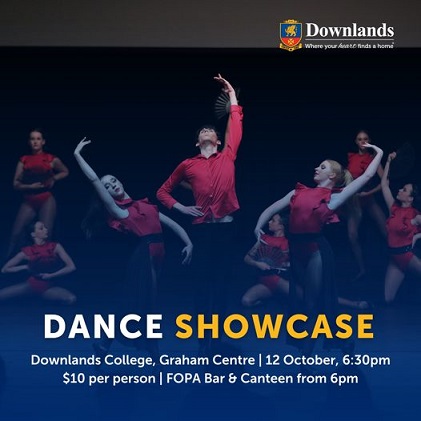
The Downlands Dance Showcase is an event that marks the end of an entire year of dance performances and competitions. You will get to witness the extraordinary talent and hard work of our Prep to Year 12 Dance Troupes, Secondary Curriculum dance items, and some of the most talented student soloists.
Daughters of Our Lady of the Sacred Heart, 150 years, celebrating the APA Safeguarding Conference
Daughters of Our Lady of the Sacred Heart, 150 years, celebrating the APA Safeguarding Conference
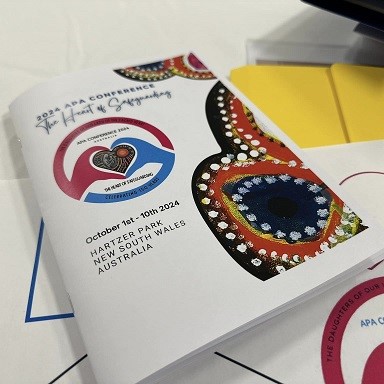
Today, our APA Safeguarding Conference officially ended.
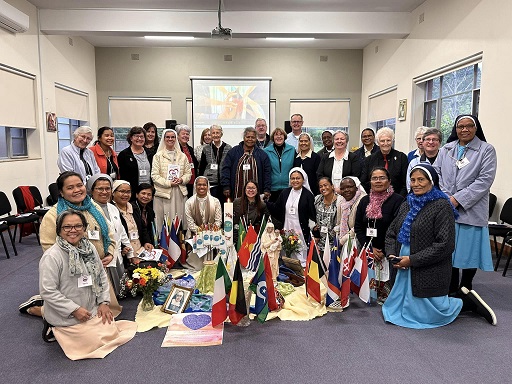
We began the day with a Eucharist hosted by Indonesia and celebrated by Fr. Kimi MSC.
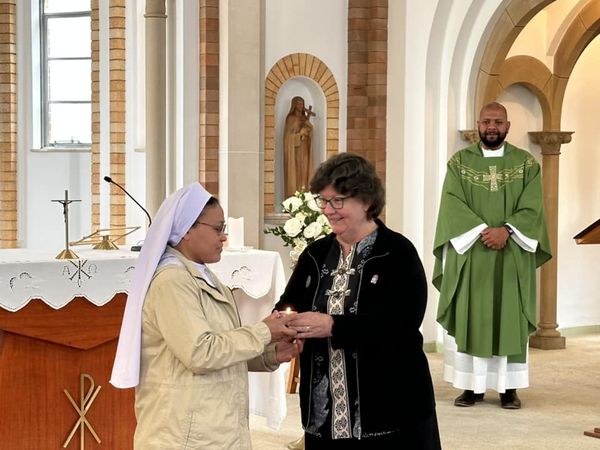
During the Eucharist, Sr. Philippa announced that the next APA Conference will be held in 2026 in Indonesia and handed the APA candle to the Indonesian Province.
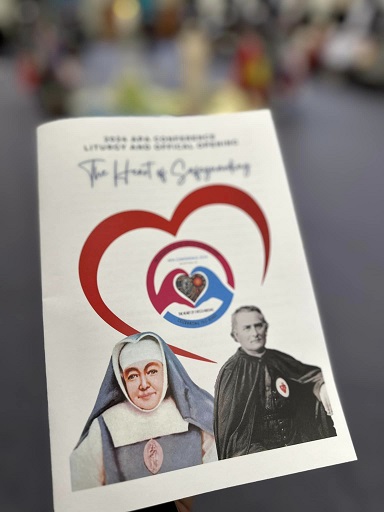
Following the Eucharist, the APA participants gathered for a final reflection and the official signing of our APA Safeguarding Commitment Statement, which was handed to Sr. Margaret Bob, the Secretary of the Congregation, to be taken to our Congregational Leader in Rome for endorsement.

Our APA Safeguarding Conference has been a truly fruitful time, during which hearts and minds were opened to deepen our commitment to safeguarding. Our APA participants will now enjoy some leisure time in Sydney before departing for their home countries.

Some photos of the Conference

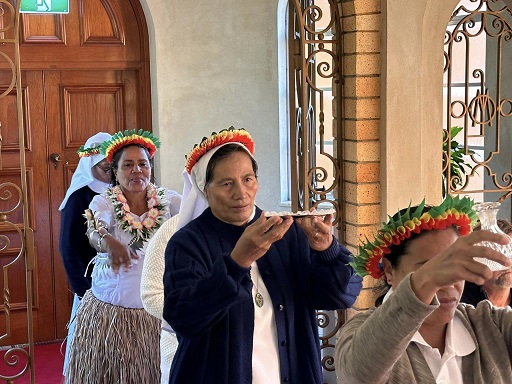
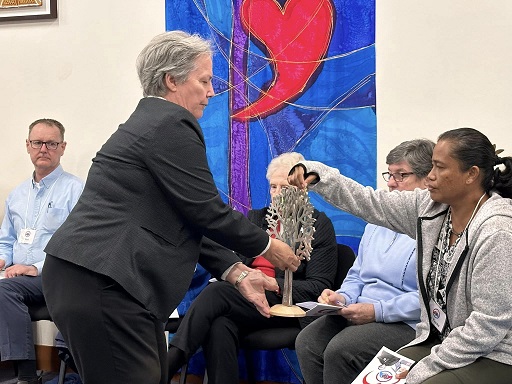
Chaplain to the Conference, Peter Hendriks MSC - blessed by Provincial, Philippa Murphy
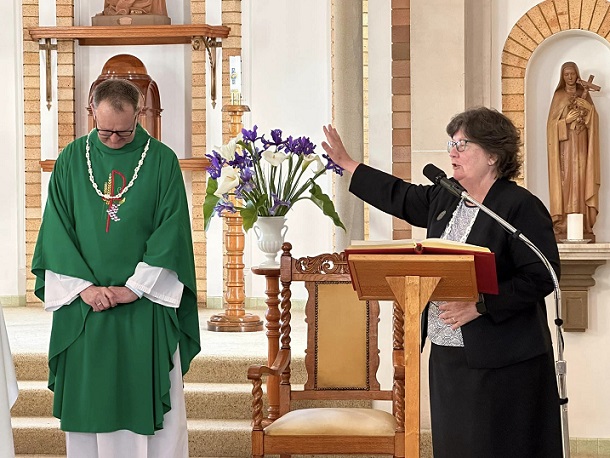
Presentation by tim Brennan MSC

For photos of visits to Sydney, Canberra and the Sisters at St Joseph’s Kensington, visit the Facebook page of the Daughters of Our Lady of the Sacred Heart, Australia.
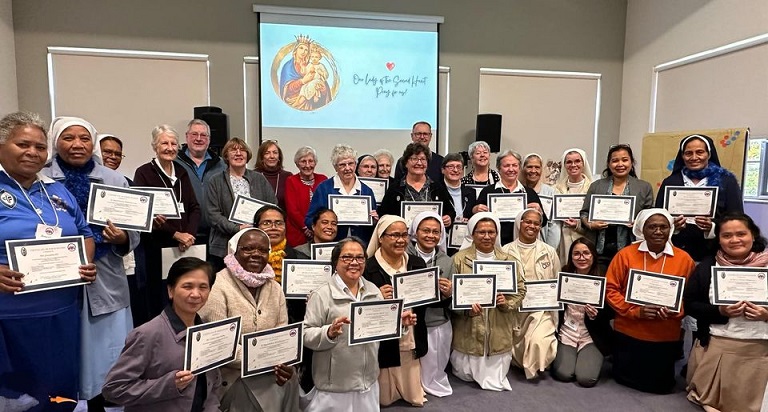
Multicultural celebration, St John’s Kippax.
Multicultural celebration, St John’s Kippax.

Thanks to Marian England, Tru MSC and Chung MSC
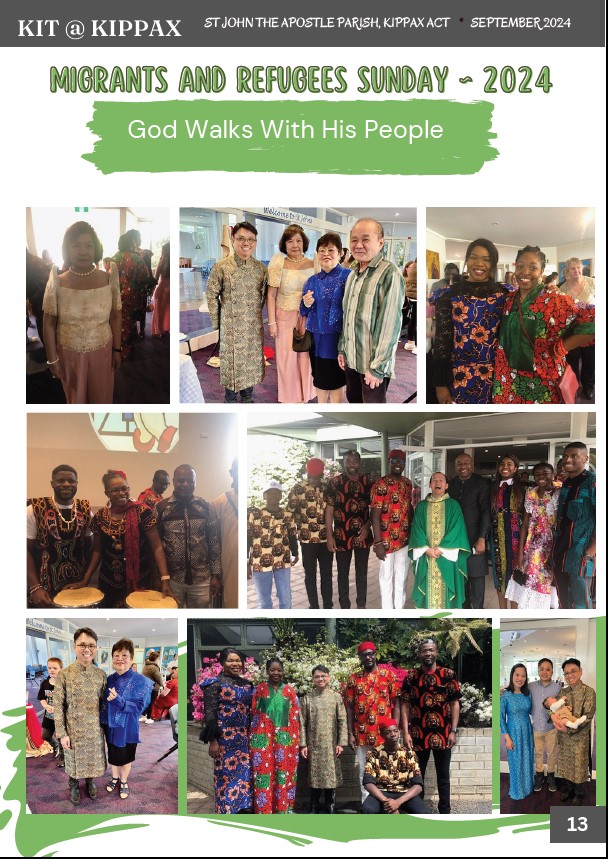
St John the Apostle Parish celebrated Migrants and Refugees Sunday with vibrant energy and rich cultural expression. The local African choir uplifted the 10:00 am Mass with their joyful music, creating an atmosphere of celebration and unity. Following the Mass, parishioners gathered for morning tea, further fostering community spirit. This event beautifully showcased the parish's cultural diversity and the warmth of its inclusive community. For Kit, the parish magazine: http://www.stjohnkippax.org.

RIP, Bishop Hugh Slattery MSC
RIP, Bishop Hugh Slattery MSC

Bishop Emeritus Hugh Partick Slattery was born on the 10th of March 1934 in Nenagh in Co Tipperary, Ireland. Feeling the call to the priesthood he joined the Missionaries of the Sacred Heart of Jesus (MSCs) and was ordained a priest In 1958. In 1984 he was appointed and ordained the Bishop of Louis -Trichardt- Tzaneen. On the 28th of January 2010 he retired and went to live in a small community to continue pastoral work. He passed away at Holy Cross Home, Pretoria on Sunday 6th of October.

His missionary life was full and varied. When the Lumko Missiological Institute was set up the MSCs were approached to provide qualified staff and Fr Hugh Slattery was missioned there. The Institute developed and provided courses in local languages and social anthropology for new missionaries. Training was also provided for catechists, and other departments were added to deliver training in pastoral and biblical studies. The Institute produced many practical training materials for various lay ministries which have been widely used around the world. In 1978, Fr Hugh Slattery co-edited Pastoral Orientation in a Changing World.
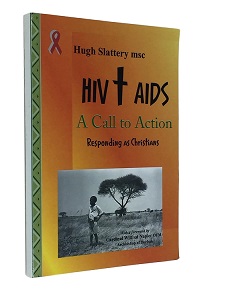
Bishop Hugh was also instrumental in the writing of the book HIV/ AIDS A Call to Action - Responding as Christians, was Inspired by the positive response he received to a Pastoral Letter he wrote on the issue. The Pastoral Letter received praise from the then Archbishop of Durban, Wilfrid Napier. In the foreword to the book, he writes: "The Pastoral letter by Bishop Hugh Slattery is a most valuable instrument in the battle not only to contain the spread of HIV/AIDS, but especially to ensure that the followers of Jesus reach out in love and compassion to those who are suffering from AIDS ... Bishop Slattery's approach will make it possible for many more Catholics to know the Church's teaching and live it. In that way they will not only make a telling impact on the spread of HIV/AIDS, but also rebuild their marriages and family life on the values of the Gospel."
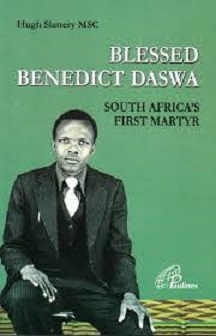
He also played an important role in having other materials published but his crowning glory was the promotion of the cause resulting in the eventual beautification of Blessed Benedict Daswa on 13 September 2015. The now Bishop Emeritus, Hugh Slattery MSC, in his book on Benedict Daswa - South Africa's First Martyr, writes "Nourished by prayer, the Word of God and the regular reception of the Sacraments, Benedict was deeply involved in the life of the parish. He was full of enthusiasm for the spread of the gospel through building up strong, local Catholic communities.”
His Three Daughters

HIS THREE DAUGHTERS
US, 2024, 101 minutes, Colour.
Carrie Coon, Natasha Lyonne, Elizabeth Olsen, Rudy Gavan, Jose Febus, Jovan Adepo, Jay O.Sanders.
Directed by Azazel Jacobs.
Anton Chekhov was first with his evocative title, Three Sisters. This time the three sisters are three daughters.
This is a very strong film about family relationships, sibling relationships, the daughters and their relationship to their father, the occasion of his dying. In fact, the father does not appear through the major part of the film, emerging from his room at the end of the film. The focus is on the three daughters.
This is a dialogue and character-driven screenplay which could easily be adapted to theatre. Most of the action takes place within a house, some scenes outside with one of the daughters smoking, a visit to a shop to buy drugs, glimpses of the street. But, mainly interiors.
The father (eventually seen in the performance of Jay O.Sanders) has had two happy marriages, to sad deaths of his wives, two daughters from his first marriage, Katie and Christina, and the stepdaughter from his second marriage whom he raised as his own, Rachel.
The action takes place over the days of the father dying at home, a nurse coming in for several hours to relieve the vigil of the sisters, the liaison officer with information about their father’s condition, and Rachel’s boyfriend who is looked down on by the older sister but who speaks his mind.
Which means that the drama is mainly the interactions between the three sisters. The film opens with the oldest, Katie (Carrie Coon) married with a family and clashes with her teenage daughter, often on the phone, but practical, cleaning, cooking, severe, difficulties with Rachel who has stayed in the house to be companion to their father over the years. Christina, the youngest, (Elizabeth Olsen) is the softer character, married, a young baby, continually caring on the phone, wanting to communicate with her sisters, having to mediate in moments of anger between the two.
Rachel is casual in her manner, a very strong performance by Natasha Lyonne. Continually smoking, drugs, watching sports on TV and betting, something which she did in companionship with her father over the years. And she is being left the house. She is moody, casual, at times seemingly uninvolved, the target of Katie’s criticisms, some feelings of resentment about the two sisters, the one who is always there for their father, supporting him, sharing his life over the years.
Which means then that His Three Daughters offers audiences strong characterisations, some powerful dialogue, some dramatic interactions. It challenges the audience to check on their own family relationships, harmonies, quarrels, times of falling out.
The themes, of course, are significant and well worth thinking about and discussing.
- The title? Reminiscent of Chekhov, three sisters?
- An American story, American families, devotion, alienation, death, clashes, reconciliations?
- The screenplay, dialogue and character driven, easily adaptable for theatre?
- The situation, the dying father, past memories, his two marriages, his daughters, their place in the family, bringing all of them up? One living in New York, the other across the country, the stepdaughter from the second marriage living at home, sharing life with him?
- The audience not seeing the father until the end, his being nursed at home, the nurse coming in for several hours and helping? The consultant and his wife, indicating death to come soon, the conversations, the sisters phoning him?
- The portrait of the three sisters? The immediate impact of Katie, oldest, her situation, marriage, clash with her teenage daughter, the phone calls, strong-minded, organising, cleaning, cooking, getting exasperated? Drinking? Attitude towards Rachel, stepsister, Rachel’s character, behaviour, living at home, the prospect of her inheriting the apartment, drugs, sports, air for her father? Her growing exasperation, harsh words, angers? Her attitude towards Christina?
- Christina, youngest, quieter, more feeling, her marriage, her daughter, the continued phone calls and her care? Care for her father, sitting with him? Katie’s attitudes, her mediation? Attitude towards Rachel, attempts at communication? The two sisters and their outbursts, her trying to mediate? Her own loss of temper?
- Rachel, her mother, her stepfather becoming her father, at home, a character, sports, continued smoking, drugs, Katie asking her to leave the house, the supervisor and smoking not permitted outside? Benji, the relationship, the sports, watching, bets, doing this with her father? Her living in the house, detached, not necessarily wanting to have it? The outsider, going to the shops, buying the drugs? The clashes with Katie? Discussions with Christina? Unwilling to go in to see her father?
- Benji, the relationship with Rachel, watching the sports, his attitude towards the sisters, Katie and her disdain, his having met her before, not remembering, his strong words to Katie? Ousted?
- The days passing, the sisters and their routines, going to see their father, sitting with him, his breathing? The issue of the signing of the declaration that he not be revived, the timing, the pressures, the eventual signature?
- The father coming out, his speaking, their care, concern, attitude towards his daughters?
- The fantasy sequence, his talking, his relationships, his memories, the links with each daughter, with Rachel? And then seeing him sitting dead?
- The prospects for the future, Christina going home to her family, Katie and her concerns with her daughter, Rachel and the apartment – and future bonds, friendship, memories?
Megalopolis
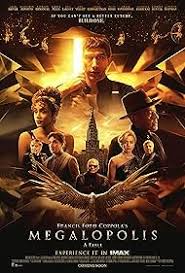
MEGALOPOLIS
US, 2024, 138 minutes, Colour.
Adam Driver, Giancarlo Esposito, Natalie Emmanuel, Aubrey Plaza, Shire LaBeouf, Jon Voight, Laurence Fishburne, Talia Shire, Jason Schwartzman, Kathryn Hunter, Dustin Hoffman.
Directed by Francis Ford Coppola.
Those who are old, who have lived a full life, deserve the opportunity to reflect on the past and what it has meant, to ponder the present and raise issues, to hope for the future. And this is what Francis Ford Coppola, memories of The Godfather and Apocalypse Now, has ventured, and the-the-top extravaganza into science fiction, futuristic fantasy, a megalopolis. It was released as Coppola turned 85. And, this review is written from the perspective of someone who is four months and one day younger than Coppola.
The setting is New Rome, a New York of the future, focus on the glitter of the Chrysler Building, other landmarks, but Coppola wants to highlight the decline of American society by likening it to the collapse, before the ultimate fall, of the Roman Empire. And the characters have evocative Roman names, Caesar, Cicero, Julia, Crassus, Clodio…
Coppola has gone for the spectacular, lavish sets, skyscrapers to a neo-coliseum with Ben Hur chariot rides and gladiator wrestling, but in the context of technological and communications developments. There is a powerful inventor of a new creative substance with multi-use, played by Adam Driver, a blend of the idealistic and the self-indulgent. He is the Caesar. There is t Mayor, Giancarlo Esposito, clinging to power. He is the Cicero. There is the ageing banker, Jon Voight, poised for a fall, manipulated by his crazy-ambitious grandson Shia LaBoeuf, and his manipulative wife, Aubrey Plaza. Voight is the Crassus. But, acknowledging the mundane glamour of media, Aubrey Plaza is Wow Platinum.
Dustin Hoffman plays a political manipulator and there are Coppola regulars from the past, Laurence Fishburne, Talia Shire (his sister) and Jason Schwartzman) his nephew).
This review will enlist the assistance of ideas from psychologist, Carl Jung. It suggests four different perspectives on how Megalopolis might read be viewed and reviewed – and may contribute to an understanding of why Coppola is intended epic has been a box office failure with barbs from critics.
If one looks at the film, really looks, sees the images, hears the music and sounds, is immersed in the sense atmosphere, there is much to dazzle, excite and admire. If one prefers to look beyond this sense excitement, to be excited by ideas, imagination, themes, the New York-N or ew Rome connections, then the film is a feast of intuitions.
There is the more subjective response, personal factors and connections, appreciations of Coppola and his work, the intrigue of the potential collapse of the American Empire, evaluation of the characters and performances, liked or disliked. And, on the other hand, there is a more objective judgement, the perspectives of critics, the question of whether Coppola’s vision is substantial or ephemeral somewhere in between. The issue of whether his insights have depth insight, the consistency of the screenplay, Coppola’s interpretation of the past, his assessment of the present, and the quality of his optimism for the future.
Megalopolis has not been popular with the wide audience, but it surely has its place in the history of cinema.
- Status of the film? In the career of Francis Ford Coppola? Ambitious, an old man, in his early 80s, filmmaking, screenplay, reflections on message?
- The visuals of the film, a future New York, New Rome, Chrysler building and reminders of New York City? Parallels with ancient Rome especially the Coliseum, wrestling and chariot races? The special effects, the stopping of time? The editing and pace?
- The cast, mixture of the young and the veterans, the status they bring to their rules?
- The use of names, the application of Caesar, Cicero, Crassus, Julia…?
- The introduction to Caesar Catalina, setting the tone of the film, on the Chrysler building, on the edge, stopping time? His invention, the material and its use? As a person, the death of his wife, the blame, Cicero and the prosecution? His work, ambitions? His lifestyle, the drugs? The encounter with Wow Platinum and the affair? Her role in the media? The antagonism towards Cicero? Crassus and the banking? Clodio and his antagonism? The encounters with Julia, the connections with her father, her attitude, assisting him, managing, the relationship, the pregnancy, her decisions with her father, the baby and her bonding with Caesar? The experience of the banking failure, the consequences? The physical attack, his injuries, hospital, his recovery? His relationship with his mother, her outbursts, seeing her in the crowd at the end?
- Julia, the initial introduction, the nightclub, her friends, the wildlife, drinking, drugs, sexuality, of relationships? Her relationship with her father? Her changing, the encounters with Caesar, on his side, managing him at events, PR, the relationship, the increasing complications, the pregnancy, the birth of the child? The culmination with her father, her mother, her final choices? The stopping of time?
- Crassus, the banker, profligate life, drinking, the family, meeting with Wow Platinum, the marriage, her manipulation, the media and interviews, her brashness, with Caesar, opportunist, the marriage, with Clodio, teaming with him, the plan, the management of the bank, to bring down Crassus? His age, careless life, realisation of what was happening, feigning his illness, turning the tables on Clodio and Wow?
- Cicero, the mayor, his wife, Julia as his daughter, his practice of the law, antagonism towards Caesar? His role in the city, his ambitions, the crises, the conflicts? Relationship with his daughter, the clashes, disappointments? The challenges and his various responses? Mediation, concessions? His reliance on his friend, and sharing the downfall?
- Clodio, young, his friends, careless, dressing as the Roman woman, partying, yet ambitious, his friend and manipulation, resorting to violence, with Well, the connections, interviews with Crassus, bringing him down, his defeat?
- Dustin Hoffman as the dealmaker, sinister, his remarks, insinuating, Cicero relying on him – Claudio and turning against him, his death?
- The chauffeur, his being the narrator, his views on characters and situations, a measure of judgement?
- The people of New Rome, the populace, the responses to the leaders, victims of the leaders?
- The film as reflections of an old man, critique of the past, ambivalence towards the present, possible hopes for the future?
Will and Harper
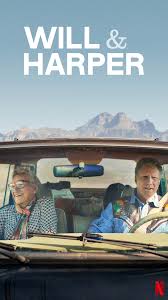
WILL AND HARPER
US, 2024, 115 minutes, Colour.
Will Ferrell, Harper Steele, and many connections from Saturday Night Live.
Directed by Josh Greenbaum.
Since the end of World War II but, especially from the 1960s on, there have been a vast number of changes in perspective on so many issues: racial equality, colonialism, communism and capitalism, refugees, disability, poverty, sexuality… We talk about them much more openly as years go on. We have experiences, for instance with migrants, opening up greater understanding. And the media, and social media…
Some of us, perhaps immediately disconcerted by new experiences, open our minds and hearts and experience a change. Some of us, shocked, threatened, hold fast to what has been handed on to us whether we understand it or not, refusing to let go.
These are some of the thoughts that come to mind immediately with Will and Harper. And, it is specifically the issue of gender identification, even more specifically, transitioning, the experience and the consequences.
When longtime friend for almost 30 years, writer for Saturday Night Live and movies for Will Ferrell, Andy Steele, emailed Ferrell to let him know that Andy was now a dead name and that she had transitioned to Harper Steele, Ferrell, like so many others, was surprised. And he came up with the idea, because of Harper’s previous now joy in driving across the United States, that they should travel together, an opportunity for discussion, for Ferrell to ask, for Harper to reflect, communicate what her life’s experience had been and now was to be.
And this film is an invitation for audiences to come along for the ride, for the experiences, for asking questions, hearing responses, empathising with the responses, learning and incorporating new perspectives.
Cameras were fitted to the front of the vehicle – but, they are at all times on occasions unobtrusive, the whole trip seeming realistic, as if we are there, observing, participating.
240 hours of film were taken but reduced to just under two hours, a variety of episodes, initial discussion with Harper’s two children and their views and experience, a visit to the Saturday Night Live set, a basketball game in Indiana, a bar in Oklahoma, a steak-eating competition in Texas, a hot air balloon ride in New Mexico. But, all the time, getting to know Harper Steele, hearing about her life, growing up in Iowa (and a visit to her sister there), self-doubts, settled for decades, therapy, decision, procedures, and the realisation that this trip was an opportunity for her to venture into familiar places in her new identity, apprehensive, sometimes reassured, some wonderful conversations but also the target of vitriolic trolling.
A two hour film where we get to know central characters offers a fine opportunity, sometimes a challenging opportunity, to understand someone, and to walk in their shoes…
- The title, introducing Will Ferrell, introducing Harper Steele?
- Audiences responding to the back story, Andrew Steele, years as a writer, Saturday Night Life, Will Ferrell’s films? Friendship with Ferrell, with the Saturday Night Life team? Andrew, marriage, children? Yet the unease, identity, gender, women’s clothes, secrecy, therapy, decision to transition, the consequences, new name, Andrew as a dead name, facing a future in his late 50s? To go out into the world with his female identity?
- Discussions about transition in the 21st-century, the past, precedents, more liberal interpretations, Conservative interpretations and condemnations of transition? Political responses, especially in the United States?
- Will Ferrell, the email giving him the information, his response, the years of friendship, the proposal of the trip, talking together, his being able to ask questions, Harper able to respond, the filming, for the record, the various activities, Ferrell inviting the audience to journey with them and share the experience?
- The importance of the initial encounter with the children and their response? The visit to Saturday Night Live at the affirmation from the friends on the set?
- The journey, the camera, unobtrusive, audiences accepting watching the couple driving, in the car, the various activities? Harper emerging, memories of the past and being accepted, wondering about acceptance now?
- The audience enjoying the activities, the basketball game, the racing cars, the hot air balloon, the night at the club in Oklahoma, Texas and the steak eating and the hostile crowd? And the visit to the hometown, and the discussions with Harper’s sister?
- The range of questions that Will Ferrell asks, questions the audience would want to ask, Harper and the probing, self questioning, realisations, apprehensions, to be appreciated, self-worth, the surprising positive reactions, Indiana and the meeting of the governor and learning of his anti-legislation? At the club in Oklahoma, the positive reactions and acceptance? The trolling and the messages after the visit in Texas?
- The realisation that an experience of a person transitioning makes a difference from theoretical analysis of the pros and cons?
- Audiences with fixed ideas, inherited, narrow, fearful? Those who invoke moral issues?
- The effect of this journey, getting to know Harper, audiences overcoming any initial fears, prejudices, the move to acceptance?
